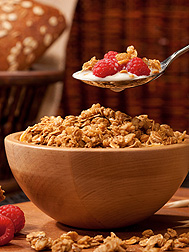Breakfast Helps Kids Handle Basic Math, Study Suggests
|
|
Even people who know a lot about the human brain may be impressed by the extent to which eating a single breakfast—or skipping it—can influence a child’s ability to solve math problems.
Just ask scientist Terry Pivik, whose research with 81 children has shown that those who ate breakfast were better able to tackle dozens of math problems in rapid-fire succession than peers who didn’t have a morning meal.
As a psychophysiologist, Pivik studies how our brains influence our behavior. Based in Little Rock, Arkansas, he directs the Brain Function Laboratory at the Agricultural Research Service-funded Arkansas Children’s Nutrition Center and is a research professor in pediatrics at the University of Arkansas for Medical Sciences.
In his study of healthy 8- to 11-year-old volunteers, Pivik used EEG (electroencephalographic) sensors to harmlessly record electrical activity generated in regions of children’s brains involved in solving math problems. The sensors were fitted into a soft cap that the youngsters wore as they viewed simple math problems presented to them on a computer monitor, calculated the answer in their heads, and then quickly selected one answer from among three onscreen choices.
In all, the kids had a little more than 1 second to process each problem.
Each child took two math tests in the morning. Half of the children ate breakfast during a break in the testing; the others did not.
Factors that could skew results were carefully controlled. For example, to prevent sleepiness, a watchful nurse and a wristband-mounted monitor that the volunteers wore ensured that each child had a full 8 hours of rest the night before the tests.
EEG data showed that “children who skipped breakfast had to exert more effort to perform the mental math that the tests required and to stay focused on the task at hand,” says Pivik. “In contrast, those who ate the breakfast that we provided used less mental effort to solve the problems, stayed more focused on the tests, and improved their scores in the post-breakfast test.”
Previous studies by researchers elsewhere have shown an association between nutrition and academic performance. However, the design of the Arkansas study had some important differences. “We carefully controlled when the kids either had breakfast or skipped it, and what they ate,” Pivik explains. “To the best of our knowledge, this is the first published study, with kids of this age group, that both controlled the morning meal and used EEG technology to monitor brain activity while the children were processing mathematical information.”
Pivik and nutrition center colleagues Yuyuan Gu and Kevin B. Tennal, along with Stephen D. Chapman—formerly at the center—published their findings in a peer-reviewed article in Physiology & Behavior in 2012.
The research is part of ongoing investigations in Pivik’s lab to discover more about how to nourish the brain and enhance children’s ability to learn. “There’s much more to uncover about the role that nutrition plays in influencing the neural networks that kids engage when they’re doing mental arithmetic,” Pivik says. “We’re addressing this knowledge gap because math skills are so critical in today’s world.”—By Marcia Wood, Agricultural Research Service Information Staff.
This research is part of Human Nutrition, an ARS national program (#107) described at www.nps.ars.usda.gov.
R. Terry Pivik is with the USDA-ARS Arkansas Children’s Nutrition Center, 15 Children’s Way, Little Rock, AR 72202; (501) 364-3346.
"Breakfast Helps Kids Handle Basic Math, Study Suggests" was published in the November/December 2013 issue of Agricultural Research magazine.







